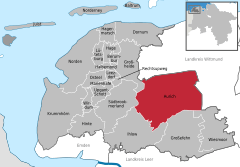Aurich
Aurich (![]()
Aurich | |
|---|---|
Aurich town centre's pedestrian zone | |
 Coat of arms | |
Location of Aurich within Aurich district   | |
 Aurich  Aurich | |
| Coordinates: 53°28′17″N 07°29′01″E | |
| Country | Germany |
| State | Lower Saxony |
| District | Aurich |
| Government | |
| • Mayor | Heinz-Werner Windhorst (Ind.) |
| Area | |
| • Total | 197.21 km2 (76.14 sq mi) |
| Elevation | 4 m (13 ft) |
| Population (2018-12-31)[1] | |
| • Total | 41,991 |
| • Density | 210/km2 (550/sq mi) |
| Time zone | CET/CEST (UTC+1/+2) |
| Postal codes | 26603 - 26607 |
| Dialling codes | 04941 |
| Vehicle registration | AUR |
| Website | www |
History
![]()
![]()
![]()
![]()
![]()
![]()
![]()
![]()
![]()
![]()
![]()
The history of Aurich dates back to the 13th century, when the settlement of Aurechove was mentioned in a Frisian document called the Brokmerbrief in 1276. In 1517, Count Edzard from the House of Cirksena began rebuilding the town after an attack. He established the town centre, which is still in place today. In 1539, the land authorities were brought together in Aurich, making it the county capital and, later, East Frisia, remaining the seat of the land authorities when East Frisia was inherited by the Kingdom of Prussia in 1744. After the Prussian Army was defeated in the Battle of Jena in 1807, Aurich became part of the Kingdom of Holland in 1808. In 1810, the Kingdom of Holland was annexed by France and Aurich was made the capital of the department Ems-Oriental of the First French Empire. After Napoleon was defeated in 1814, it passed to the Kingdom of Hanover in 1815, and then was annexed by Prussia in 1866 and made part of the Province of Hanover.
From October 21, 1944, until December 23, 1944, a Nazi concentration camp was established in Aurich. The camp was a subcamp to the Neuengamme concentration camp.[2]
After World War II, Aurich became part of the new state of Lower Saxony.
Local council
The local council has 40 members The elections in September 2016 showed the following results[3]
- SPD: 13 seats
- CDU: 11 seats
- AWG 4 seats
- Gemeinsam für Aurich (GfA), 4 seats
- Alliance 90/The Greens 3 seats
- The Left 2 seats
- Grün-Alternative Politik (GAP)(Green alternative politics) 2 seats
- FDP, 1 seat
Coat of arms
Aurich's coat of arms is drawn by the blazon: "Arms: Landscape with chief two-thirds sky and base third earth, a shield Gules emblazoned with letter 'A' Or, an open-topped crown Or above, two growing trees Vert at sides. Crown: A battlement Gules with three merlons and two embrasures. Supporters: Two branches of mistletoe with leaves and berries Or.".
Note that the coat of arms of the eponymous district differs.
Notable residents

- Liefmann Calmer (1711–1784), important personage in French Jewry of the eighteenth century
- Rudolf von Jhering (1818–1892), jurist
- Karl Deichgräber (1903–1984), classical philologist
- Rudolf Eucken (1846–1926), German philosopher, winner of the 1908 Nobel Prize for Literature
- Karl Heinrich Ulrichs (1825–1895), writer
- Friedrich August Peter von Colomb (1775–1854), Prussian general
- Yitzhak Raveh (1906–1989), Israeli judge
- Aloys Wobben (born 1952), German engineer
See also
Notes
- Landesamt für Statistik Niedersachsen, LSN-Online Regionaldatenbank, Tabelle 12411: Fortschreibung des Bevölkerungsstandes, Stand 31. Dezember 2018.
- The camp is listed as No. 51 Aurich, Kreis Aurich in the official German list.
- www.aurich.de: Stadtratswahlen 2016, abgerufen am 28. Dezember 2016.
References
- Official German list of concentration camps Record of the concentration camp and its sub-camps (in German)